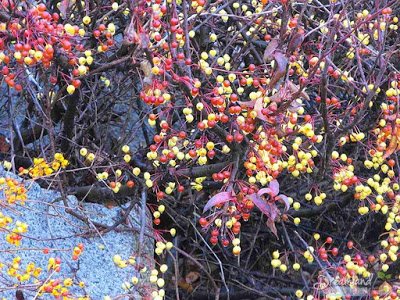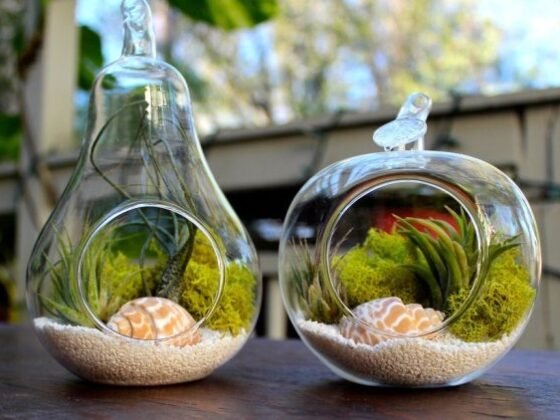Table of Contents Show
 |
| Autumn Bittersweet |
And, you should do something about some of them. I don’t recommend removing every last one, but a general cleanup is useful and looks more tidy – for a day or two! Remember that the mower can be used to “sweep” up lots of leaves, crushing them into compost-sized particles that can be spread around like mulch, or can go right into the composter.
Still, some leaf cover is desirable for the winter. It provides protection and warmth and holds in soil moisture. Other outdoor chores in October include dividing and transplanting certain perennials, and planting spring-blooming seeds and bulbs.
Winter fertilizer should be applied to lawns in October, along with soil amendments. Consider applying gypsum or liquid products that help break up dense clay or compacted soils. These amendments will work over the winter to loosen the soil for spring cultivation. Keep mowing grass as long as necessary and to pick up leaves and debris.
It’s time to starting bringing in outdoor furniture and to create order in the garage or gardening shed. Clean tools and store them well so they’ll be easy to find next spring. Also, bring in houseplants before the temperature drops below 60 degrees at night. Cut back and do not feed for another month or so. Water sparingly. Place near a sunny window and away from cold drafts and heat registers.
Think about planting some spring bulbs in containers for bright winter blooms indoors between December and March. It’s not too late to plant spring bulbs outdoors, if you didn’t get to it last month. Tulips should be planted in October, if it’s consistently cold enough outdoors.
Remember, all jobs done this fall will make spring tasks less burdensome.
Indoor Greenhouse
Set up an indoor greenhouse (Go to Indoor Greenhouse on Home Page for details on setting this up.) It’s inexpensive, easy to construct and you’ll use it all winter if not for starting seeds then for ailing houseplants and for starting stem cuttings that will be transplanted outdoors in the spring.
Use the indoor greenhouse to perk up houseplants and patio containers that have been brought indoors and are languishing from the change in conditions.
Forcing Bulbs
Go to Forcing Bulbs on the Home Page for lots of details on how to handle forcing different kinds of bulbs.
Use only the best bulbs you can find for forcing indoors. Usually, you must buy new, hardy bulbs for successful forcing indoors. Try paperwhites, tulips, hyacinth and daffodils. They should be available in October at garden centers and nurseries.
Timing is everything if you want indoor blooms for the holidays. Start narcissus indoors in October for Christmas bloom. Tulips need eight to 12 weeks of cold treatment before they will bloom indoors. Hyacinth and daffodils also need a period of cold and won’t bloom for eight to 10 weeks.
Mail Order
If you are ordering spring bulbs for fall planting, do it as soon as possible. These should be in the ground by the end of November.
Houseplants
Bring in houseplants that are still outside. The average date of the first frost is soon approaching in most zones.
If there are any container plants, such as geranium or petunia, that you want to keep inside for the winter, bring them in or transplant them in October in new containers. Remember that they need sufficient light, and not much water or food during the winter months.
Plants that over-winter fairly well are asparagus fern, vinca, coleus, lantana, petunia and geranium. Before bringing them in, inspect for bugs and disease. Keep checking them indoors for signs of problems and treat as needed.
If you’re been caring for a poinsettia, October is the time to start placing the plant in a dark closet each night for the next 10 weeks. During this time, poinsettias need about 14 hours a night of nearly total darkness, followed by up to 10 hours of light each day.
Outdoors
October Tips for Lawn Care
Remove leaves that are mounded or matted against the house, around downspouts and drainage areas, or if they are suffocating perennials and shrubs. Don’t allow fallen leaves to mat down on lawns, where they can kill young grass.
Overseeding (spreading seed on a mature lawn) should ideally be done in September, but you can still do it in October. This works best if you dethatch and then verticut or aerate first. Keep watered if rainfall is inadequate.
Apply winter fertilizer or weed-and-feed. If you have started new seed, apply a lawn-starting preparation, not a full-strength fertilizer, which is too strong.
Apply soil amendments such as lime and gypsum and liquid products that seep into clay and compacted soil and help break it over the winter.
When overseeding, applying soil amendments or fall fertilizer, mow first to remove fallen leaves, twigs, acorns and other debris that would prevent the chemicals, granules or seeds from reaching the soil. If grass is still growing, now it at the highest setting.
Do a lawn-mower cleanup. Wipe off the exterior. Hose down the bag and remove all other debris before winter storage. Empty the tank of gas if it’s more than half full. Store away from ignition sources, such as hot water heaters and furnaces.
Annuals
At the first killing frost, remove dying summer annuals, such as zinnias, marigolds, petunias, coleus, impatiens, geraniums and discard, unless you want to catch some seeds by shaking the flower heads upside down into a dish. Then, spade these soil beds to prepare for planting of spring bulbs in October and November.
Many pansies are hardy and will bloom through the cool fall months. Some will even over-winter and pop up next spring. To help, keep them mulched for the winter.
Dahlias are in flower, but will suffer from effects of the first frost. After they are spent, dahlias may be cut to the ground, or allowed to die down before heir roots are dug for the winter in the central and northern zones. Some dahlias will over-winter in the southern regions that stay warm enough during winter. Check your zone conditions. Store dahlia roots in a cool, humid place in sawdust, straw or soil-less medium.
Replace annuals with lovely and exotic bunches of ornamental kale or rose cabbage plants available at many nurseries in October. Ornamental kale comes in pale to deep violet, cream and green. This cool weather vegetable planted in bunches makes a striking fall and early winter “flower.” These can last a long time if the winter is mild. Keep them watered and watch for insect pests eating the leaves.
 |
| Purple Ornamental Kale |
October Tips for Bulbs
Some tender bulbs, if they aren’t fall bloomers or have stopped blooming, can be dug and brought indoors in October. Those include dahlia, cannas, gladiolus, tuberose and elephant ear. Cut off any leaves and flower heads. Shake or rinse off excess soil. Let dry. Store in a cool, dry and dark place, in sawdust, straw or a soil-less mixture.
Some gladiolus will over-winter outdoors in more moderate zones if they are in a protected place, such as near the house, and they are covered by deep mulch or leaves. But ordinarily, they should be dug and stored for the winter in the central and northern zones.
Plant tulips and daffodils as long as the weather has turned consistently cool. Daffodils may be planted in early October. Tulips often must be planted in late October or November, when the temperatures have become decidedly chilly.
Plant bulbs away from the front edge of borders, so that annuals and perennials can disguise their dying leaves next spring. Also, plant bulbs in groups of five or more for the best show. Never plant in a thin line around a garden border.
To keep rodents, such as mice and squirrels from digging up and eating flower bulbs, cover the planting area with chicken wire, or enclose the bulbs in an underground basket before covering with soil.
Throw a teaspoon or so of bone meal in with each bulb. This supplies nutrients for the blooms that will appear next spring.
October Tips for Perennials
Chrysanthemums are in bloom and should be fed and watered. Watch for pests such as black aphids, thrips, leaf miners, leafhoppers, tarnished plant bugs, red spiders and two-spotted mites. Apply treatments as needed. Also watch for leaf spot and mildew.
In October, sow spring-blooming perennial and annual seeds outdoors, including hollyhock, poppy, larkspur, bachelor button, dianthus and others.
Before perennials die back completely, label their locations so you’ll know where to look for them in the spring and to avoid digging them up accidentally.
Before peony leaves fall off, cut the stems as low as possible without injuring the dormant buds just at the soil level. Mark peony plantings to avoid damaging them during spring cultivation.
Perennials in Bloom Until Frost
It’s late in the flowering season, but many perennials will bloom until the first hard frost. Here are some to look for:
| Anthemis (Golden Marguerite) | Aster (Hardy) | Coreopsis (Tickseed) |
| Cupid’s Dart (Catanache) | Anthemis (Golden Marguerite) | Chrysanthemum |
| Daylily | Delphinium | Felicia (Blue Daisy) |
| Fleabane (Erigeron) | Helianthus (Perennial Sunflower) | Heliopsis (Oxeye) |
| Liatris (Gay Feather) | Potentilla (Cinquefoil) | Rudbeckia (Coneflower/Echinacea) |
Dividing, Seeding and Transplanting Perennials in the Fall
Many perennials can still be seeded (as in the above section) or divided and transplanted in October.. However, the sooner the better this month. With small seedlings or root cuttings, wait until spring. Here is a list of some of the plants that can be propagated in October.
- Adonis – seed outdoors
- Anchusa (Catchfly/Maltese Cross) – seed outdoors or will reseed itself
- Artemesia (Silver Mound) – root division, seed outdoors, or take stem cuttings that must be over-wintered indoors and transplanted outdoors in spring
- Balloon Flower (Platycodon) – root division
- Bleeding Heart (Dicentra) – root division
- Brunnera (Siberian Forget-Me-Not) – seed outdoors
- Candy Tuft (Iberis) – seed outdoors
- Chinese Lantern (Physalis) – root division
- Coral Bells (Heuchera) – root division
- Coreopsis (Tickseed) – seed outdoors
- Daylily – root division
- Dianthus (Pinks/Sweet William) – seed outdoors, stem cuttings must be over-wintered indoors before spring transplanting
- Fleabane (Erigeron) – root division
- Hollyhock – seed outdoors
- Hosta (Funkia/Plantain Lily) – seed outdoors or divide crowns
- Iris – divide rhizomes
- Lungwort (Pulmonaria) – seed outdoors
- Lychnis (Catchfly/Maltese Cross) – seed outdoors
- Pansy (viola) – seed outdoors
- Peony – root division
- Phlox – root division
- Rudbeckia (Coneflower/Echinacea) – root division or seed outdoors
- Oriental Poppy – seed outdoors or root division)
- Scabiosa (Pincushion Flower) – seed outdoors or root division
- Shasta Daisy – root division
- Spurge – root division
- Stokesia (Stokes’ Aster) – root division
Pests and Diseases
Here that chirp, chirp, chirp? Yes, the crickets are here. To discourage them from coming indoors, spread moth crystals or mothballs around the foundation outdoors and along floorboards indoors, in the basement or garage (if you can stand the odor!). Moth crystals are not recommended for broad usage inside the home because of their fumes and they can be toxic to children and pets if ingested.) But, otherwise, mothballs and moth crystals also seem to discourage mice in the garage and basement areas.
Spiders and moths also will be looking for warm winter abodes, and wool materials to eat. To discourage them, spray around housing foundations and remember to keep cedar blocks or cedar balls or use moth crystals or moth balls around wool materials.
Outdoors, the Virginia creeper is turning red but don’t confuse it with poison ivy and poison sumac! These vines also turn red in the late summer and fall.
Tools and Equipment
In a heated garage, set up a winter work area. For example, place an old table in a corner. There, you can do “outdoor” work in the garage during the winter months. You’ll be able to plant seed flats, do transplants and make a mess in the garage instead of in your basement, family room or kitchen. This allows you to keep getting your hands dirty and will give you a gardening “fix” during those gray winter days.
If you didn’t get to it in September, October is the time to clean, organize and store gardening tools, chemicals and equipment for the winter. Put up a pegboard or shelving to help with organizing all these items. Roll up hoses, put away watering cans, toss out empty containers and throw dirty gloves in the washer.
Trees and Shrubs
Many gardeners choose the fall to transplant new deciduous (non-evergreen) trees and shrubs. The exceptions to fall planting are magnolia, birch, beech, tulip tree, sweet gum and flowering dogwood. These are better transplanted in spring. Also, among shrubs, butterfly bush is best moved in spring.
October is a choice month for planting evergreens. No need to prune when transplanting them, since they continue growing during the winter months. Also, continuous watering is not necessary, but mulch is recommended.
Keep newly planted deciduous trees and shrubs moist to encourage root growth. Make sure they are well mulched and that small or vulnerable branches are supported against damaged from wind or heavy snow or ice.
Fall colors are best when the weather cooperates. For leaves to turn scarlet, gold, yellow, orange, red and purple, trees need cool nights followed by warm, bright, sunny days. But, trees also need to be healthy, and should be in open areas where they get plenty of sunlight. Another factor that helps create glorious fall color is the delay of a hard freeze. Leaf color tends to be poor during fall seasons when there has been mostly cloudy, rainy and warm weather, and when there has been an early hard freeze.
In deciding what new deciduous tree to plant, consider its fall color. Here are some examples.
- Red – amur maple, Chinese elm, dogwood, hawthorn, Japanese maple, Japanese mountain ash, Japanese pagoda, pin oak, red maple, red oak, sugar maple, sassafras, scarlet oak, service berry, shingle oak, sumac, sour wood, sugar maple, sweet gum, tupelo, white poplar.
- Orange – buckeye, crab apple, dogwood, Korean ash, service berry, red maple, silver maple, sour gum, sugar maple and yellowwood.
- Yellow – ash, beech, birch, box elder, crab apple, butternut, Chinese chestnut, Chinese elm, larch, linden, locust, hackberry, hickory, horse chestnut, Norway maple, pecan, poplar, redbud, Russian olive, service berry, shingle oak, sweet gum, sycamore, tulip tree, walnut, willow, willow oak and yellowwood.
- Purple – ash, white oak.
Trees that usually retain their leaves during the winter are pin oak, scarlet oak, shingle oak, post oak and ironwood. These trees will shed their leaves in the spring.
This time of year, some white pines drop their needles from two- or three-year-old wood, as do scotch pines, but this is normal.
To keep rabbits and other chewing rodents from damaging the bark of certain trees, wrap the trunks with cloth or a binding made especially for this purpose. Rabbits tend to like nibbling on fruit trees, flowering crabapple, flowering quince, pussy willow, euonymus, ginkgo, viburnum and dogwood.
Pruning
Trim Rose of Sharon bushes in October. They will produce next year’s flowers on new spring growth. In general garden cleanup, prune any dead branches on trees and shrubs.
Watering
It’s about time to put away the water hoses and turn off the outdoor spigots to avoid frozen pipes. However, ornamental kale and chrysanthemums, and any newly transplanted deciduous trees and shrubs should be watered periodically in the fall. This is especially important when rainfall has been inadequate. This time of year, inadequate rainfall means a period of four to six weeks without rain.
Birds
Cardinal pairs (the bright red is the male), gold finches, chickadees and sparrows are flitting around, seeking winter cover. They’re also looking around your yard for flower seeds to eat, so don’t cut down all the echinacea, sunflowers, bittersweet, wild blackberry bushes and other such growth.
Start putting out bird feeders any time, but remember those pesky squirrels will be drawn to them immediately and always seem to figure some way to steal the seeds. Still, putting out food in October for the birds encourages them to stay around your neighborhood and revisit your yard.
Keep the birdbath filled because it also furnishes drinking water, which can become scarce at times in the autumn.
Miscellaneous
Take some photos of colorful trees in your yard or anywhere you see them. This will help you with planning, but also will aid in identifying trees you want to plant. Autumn color photos also make pretty framed pictures!
Stop and write a few pages in the garden journal about what worked, what didn’t work, what you’d like to try next season, things you’ve seeded or transplanted in October, etc. Note the birds you see, the other animal activity, the first expected frost date, the first hard freeze, etc.










